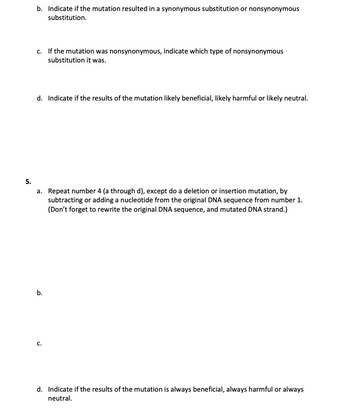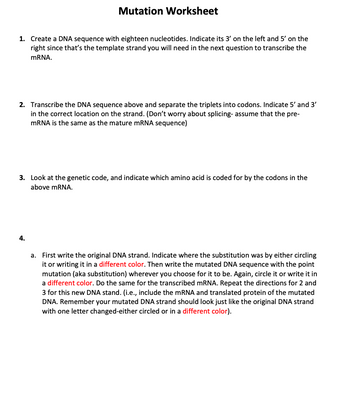
Concept explainers
ANSWERS 1-4 were answered but I need 5 answered please.
5. ANSWER QUESTIONS BELOW PLEASE:
A. Repeat number 4 (a through d), except do a deletion or insertion mutation, by subtracting or adding a
B.
C.
D. Indicate if the results of the mutation is always beneficial, always harmful or always neutral.
QUESTIONS ANSWERED BELOW
Answer 1) The sequence of template strand in 3' to 5' sequence is:
3' TACCCGCCAGCCTACATC 5'
Answer 2)
The mRNA strand is complementary to the template strand. The RNA polymerase synthesises mRNA. The A, U, G and C are present in mRNA with respect to the T, A, C and G in DNA.
The mRNA sequence is: 5' AUGGGCGGUCGGAUGUAG 3'
The mRNA sequence in form of codon is: 5' AUG GGC GGU CGG AUG UAG 3' The codon is made up of three nucleotides.
Answer 3) The mRNA codon chart helps to find the sequence of amino acid from a codon. The start codon initiates translation. Sto codon (UAA, UAG or UGA) terminates translation. The protein sequence is: N- met- gly- gly- arg- met- C
Answer 4)
a. The sequence of original strand is: 3' TACCCGCCAGCCTACATC 5'
The first G nucleotide is mutated to C.
The mutated DNA sequence is: 3' TACCCACCAGCCTACATC 5'
The mutated mRNA sequence is: 5' AUGGGUGGUCGGAUGUAG 3'
The mutated mRNA sequence in fork of codons is: 5' AUG GGU GGU CGG AUG UAG 3'
The protein sequence is: N- met- gly- gly- arg- met- C
B. The mutation is synonymous in nature because amino acid remains same even after mutation.
C. This is not a kind of non synonymous mutation because amino acid remains same in wild type and mutated type.
D. The mutation is likely to be neutral in nature. The wild type and mutated proteins have same sequence of amino acids. That's why function of both proteins remain same.


Trending nowThis is a popular solution!
Step by stepSolved in 2 steps with 3 images

 Human Anatomy & Physiology (11th Edition)BiologyISBN:9780134580999Author:Elaine N. Marieb, Katja N. HoehnPublisher:PEARSON
Human Anatomy & Physiology (11th Edition)BiologyISBN:9780134580999Author:Elaine N. Marieb, Katja N. HoehnPublisher:PEARSON Biology 2eBiologyISBN:9781947172517Author:Matthew Douglas, Jung Choi, Mary Ann ClarkPublisher:OpenStax
Biology 2eBiologyISBN:9781947172517Author:Matthew Douglas, Jung Choi, Mary Ann ClarkPublisher:OpenStax Anatomy & PhysiologyBiologyISBN:9781259398629Author:McKinley, Michael P., O'loughlin, Valerie Dean, Bidle, Theresa StouterPublisher:Mcgraw Hill Education,
Anatomy & PhysiologyBiologyISBN:9781259398629Author:McKinley, Michael P., O'loughlin, Valerie Dean, Bidle, Theresa StouterPublisher:Mcgraw Hill Education, Molecular Biology of the Cell (Sixth Edition)BiologyISBN:9780815344322Author:Bruce Alberts, Alexander D. Johnson, Julian Lewis, David Morgan, Martin Raff, Keith Roberts, Peter WalterPublisher:W. W. Norton & Company
Molecular Biology of the Cell (Sixth Edition)BiologyISBN:9780815344322Author:Bruce Alberts, Alexander D. Johnson, Julian Lewis, David Morgan, Martin Raff, Keith Roberts, Peter WalterPublisher:W. W. Norton & Company Laboratory Manual For Human Anatomy & PhysiologyBiologyISBN:9781260159363Author:Martin, Terry R., Prentice-craver, CynthiaPublisher:McGraw-Hill Publishing Co.
Laboratory Manual For Human Anatomy & PhysiologyBiologyISBN:9781260159363Author:Martin, Terry R., Prentice-craver, CynthiaPublisher:McGraw-Hill Publishing Co. Inquiry Into Life (16th Edition)BiologyISBN:9781260231700Author:Sylvia S. Mader, Michael WindelspechtPublisher:McGraw Hill Education
Inquiry Into Life (16th Edition)BiologyISBN:9781260231700Author:Sylvia S. Mader, Michael WindelspechtPublisher:McGraw Hill Education





